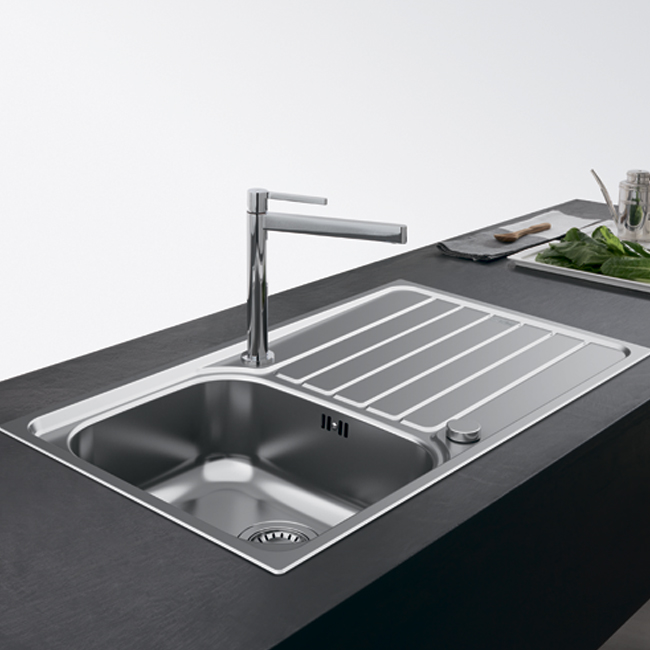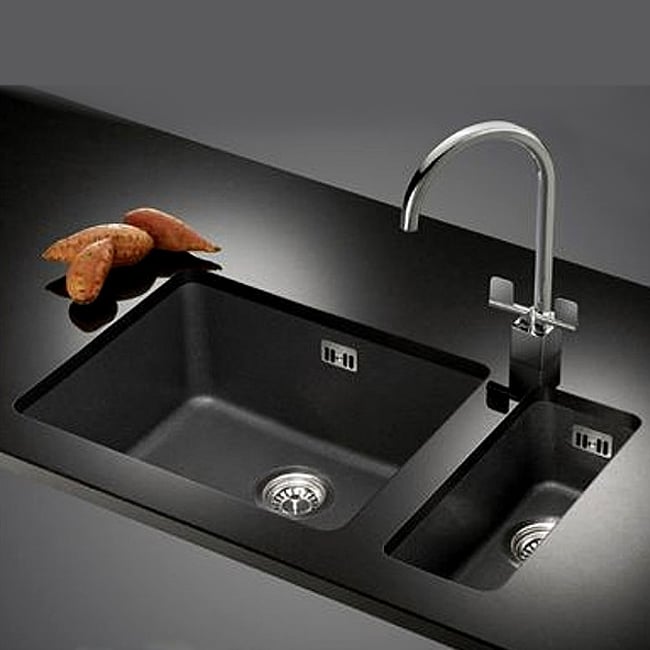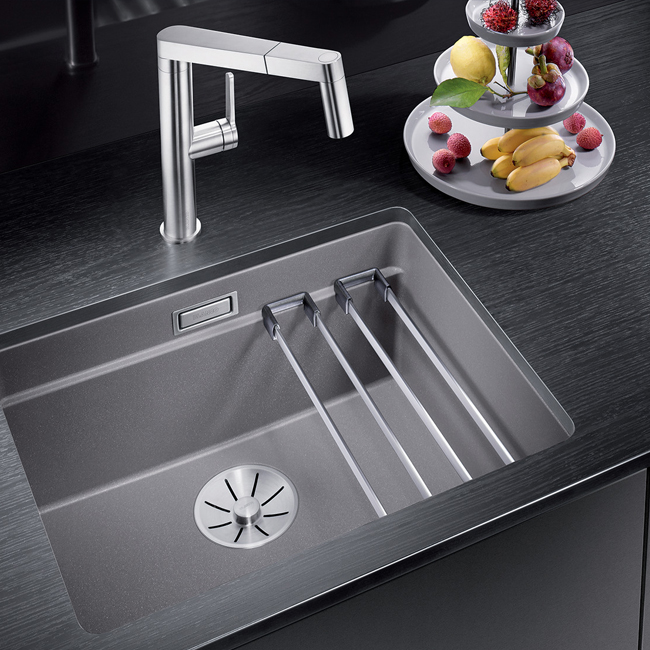

In this kitchen sink guide, we will try to make it easier with how to choose the right look and model of sink for your kitchen.
Different Materials Used in Kitchen Sinks
Stainless
Stainless steel kitchen sinks offer style and functionality for daily kitchen tasks. They can be one of the most affordable types of kitchen sinks. A stainless steel kitchen sink is made from a combination of alloys. The materials used in its composition are iron, chromium, and nickel. Stainless steel is a sturdy material that offers durability and low maintenance. A variety of bowls are available in a stainless steel kitchen sink which makes it easier to choose the right one for you.
Here are the Best Stainless Steel Kitchen Sinks:
Composite
Composite kitchen sinks offer a high level of functionality and durability. These sinks add to the elegance of any kitchen. The composition of these sinks are from materials such as quartz and acrylic resins. These materials are the reason why composite kitchen sinks are heat and scratch-resistant. The non-porous structure of composite sinks shields them better from bacteria and better prevents stain build-up. Simply amazing for the maintenance of a hygienic space. Designs mostly have a muted finish with numerous color options which. Various options for bowl sizes help in having the right choice to meet the needs of most kitchens.
Here are the Best Composite Sinks:
Ceramic
Ceramic kitchen sinks are made from clay. They bring a natural tone to your kitchen by giving an elegant finish. Their neutral shade provides a fresh look. Ceramic is a timeless choice for those kitchens which have a heritage interior. Ceramic kitchen sinks are designed with an integrated reversible drainer for a dedicated draining space whatever the layout.
Here are the Best Ceramic Sinks:
Different Types of Kitchen Sinks
Inset
Inset sinks are among popular types of a kitchen sink as they are most straightforward to install. Inset sinks are mounted from above, whereby the bowl drops into a hole prepared in the work surface and the rim then overlaps and rests on the top. These sinks are compatible with different surface materials. Inset sinks often have a built-in drainer but there is also a variety of these sinks without a drainer. They suit both traditional and contemporary kitchens.
Undermount
Undermount sinks are defined by the way they are installed in relation to the kitchen countertop. These sinks are installed under the counter, rather than being dropped into a pre-cut hole in the countertop. A non-porous material should be used to prevent water ingress. It will save the surface and cabinetry from damage. You can have both, single-bowl and double-bowl undermount sinks.
Different bowl sizes
Single bowl
Being a compact option, a single bowl is a good choice for a kitchen with limited space. They are a great addition to the smaller spaced-kitchen by offering a minimal and uncluttered look.
1.5 bowl
These sinks offer the benefits of a two-bowl setup without taking up as much room. Great choice for a smaller kitchen where two bowls are required. The addition of a second, half-sized bowl is useful for tasks such as washing vegetables or rinsing off crockery when the larger bowl is full.
Double bowl
For bigger kitchens, this type of sink with two full sized bowls is best suited for larger families. These double bowl sinks provide enough space for preparing food and washing up dishes when you cook.
Colour Options
Black
Black looks beautiful by giving a contemporary appearance in most kitchens. Less prone to marks or stains, are why this colour is a great choice to have.
White
White has the tendency to complement a huge range of designs. White hues brighten a room by creating a spacious look. By mixing with bold colours, the overall interior of the kitchen can give a clean fresh appearance.
Grey
For a sophisticated area, a grey colour offers a neutral yet elegant effect. Grey can be used to soften a dark colour. It can also be used with pale tones to have an airy look. By selecting grey, you can add to the elegance of most kitchen layouts.
Planning considerations
Tap holes
Having a clean, less fussy area, a perfect tap helps which can affect your choice of bowl also. Inset and counter top sinks have one or two holes pre-drilled to accommodate taps. A single hole will suit a monobloc tap, which combines hot and cold water. Two holes can be used for pillar style separate hot and cold taps but also two hole mixer taps. Increasingly in newer kitchens, filter water taps are becoming popular. From pull out taps to deck mounted kitchen taps, you can choose from a wide range to complement your kitchen.
Selecting Surfaces
A work surface also plays an important role in your kitchen. You can opt from a variety of different materials which may determine the type of sink you would prefer. Your Belfast or undermount type of sink can perfectly go with nonporous materials like solid stone, that are water resistant. To support inset fittings, laminate is usually the preferred material.
Sealing and Securing
You need to ensure that after installation your kitchen sink is perfectly sealed to prevent leaks and consequently possible water damage to cabinets. For a tight seal, silicon is a great choice because it is moisture resistant and prevents mould from growing on its surface. It can aid in maintaining a clean and hygienic kitchen sink area.
In Summary
Although we have touched on only briefly, you will see that there are many factors which need to be considered when you are selecting a kitchen sink. From the choice of worktop to available color options and styles of sinks, there is much to consider.
Inset sinks are among popular types of a kitchen sink as they are most straightforward to install. Inset sinks are mounted from above, whereby the bowl drops into a hole prepared in the work surface and the rim then overlaps and rests on the top. These sinks are compatible with different surface materials. Inset sinks often have a built-in drainer but there is also a variety of these sinks without a drainer. They suit both traditional and contemporary kitchens.
Undermount sinks are defined by the way they are installed in relation to the kitchen countertop. These sinks are installed under the counter, rather than being dropped into a pre-cut hole in the countertop. A non-porous material should be used to prevent water ingress. It will save the surface and cabinetry from damage. You can have both, single-bowl and double-bowl undermount sinks.
Being a compact option, a single bowl is a good choice for a kitchen with limited space. They are a great addition to the smaller spaced-kitchen by offering a minimal and uncluttered look.
These sinks offer the benefits of a two-bowl setup without taking up as much room. Great choice for a smaller kitchen where two bowls are required. The addition of a second, half-sized bowl is useful for tasks such as washing vegetables or rinsing off crockery when the larger bowl is full.
For bigger kitchens, this type of sink with two full sized bowls is best suited for larger families. These double bowl sinks provide enough space for preparing food and washing up dishes when you cook.
Black looks beautiful by giving a contemporary appearance in most kitchens. Less prone to marks or stains, are why this colour is a great choice to have.
White has the tendency to complement a huge range of designs. White hues brighten a room by creating a spacious look. By mixing with bold colours, the overall interior of the kitchen can give a clean fresh appearance.
For a sophisticated area, a grey colour offers a neutral yet elegant effect. Grey can be used to soften a dark colour. It can also be used with pale tones to have an airy look. By selecting grey, you can add to the elegance of most kitchen layouts.
Having a clean, less fussy area, a perfect tap helps which can affect your choice of bowl also. Inset and counter top sinks have one or two holes pre-drilled to accommodate taps. A single hole will suit a monobloc tap, which combines hot and cold water. Two holes can be used for pillar style separate hot and cold taps but also two hole mixer taps. Increasingly in newer kitchens, filter water taps are becoming popular. From pull out taps to deck mounted kitchen taps, you can choose from a wide range to complement your kitchen.
A work surface also plays an important role in your kitchen. You can opt from a variety of different materials which may determine the type of sink you would prefer. Your Belfast or undermount type of sink can perfectly go with nonporous materials like solid stone, that are water resistant. To support inset fittings, laminate is usually the preferred material.
You need to ensure that after installation your kitchen sink is perfectly sealed to prevent leaks and consequently possible water damage to cabinets. For a tight seal, silicon is a great choice because it is moisture resistant and prevents mould from growing on its surface. It can aid in maintaining a clean and hygienic kitchen sink area.
Although we have touched on only briefly, you will see that there are many factors which need to be considered when you are selecting a kitchen sink. From the choice of worktop to available color options and styles of sinks, there is much to consider.















